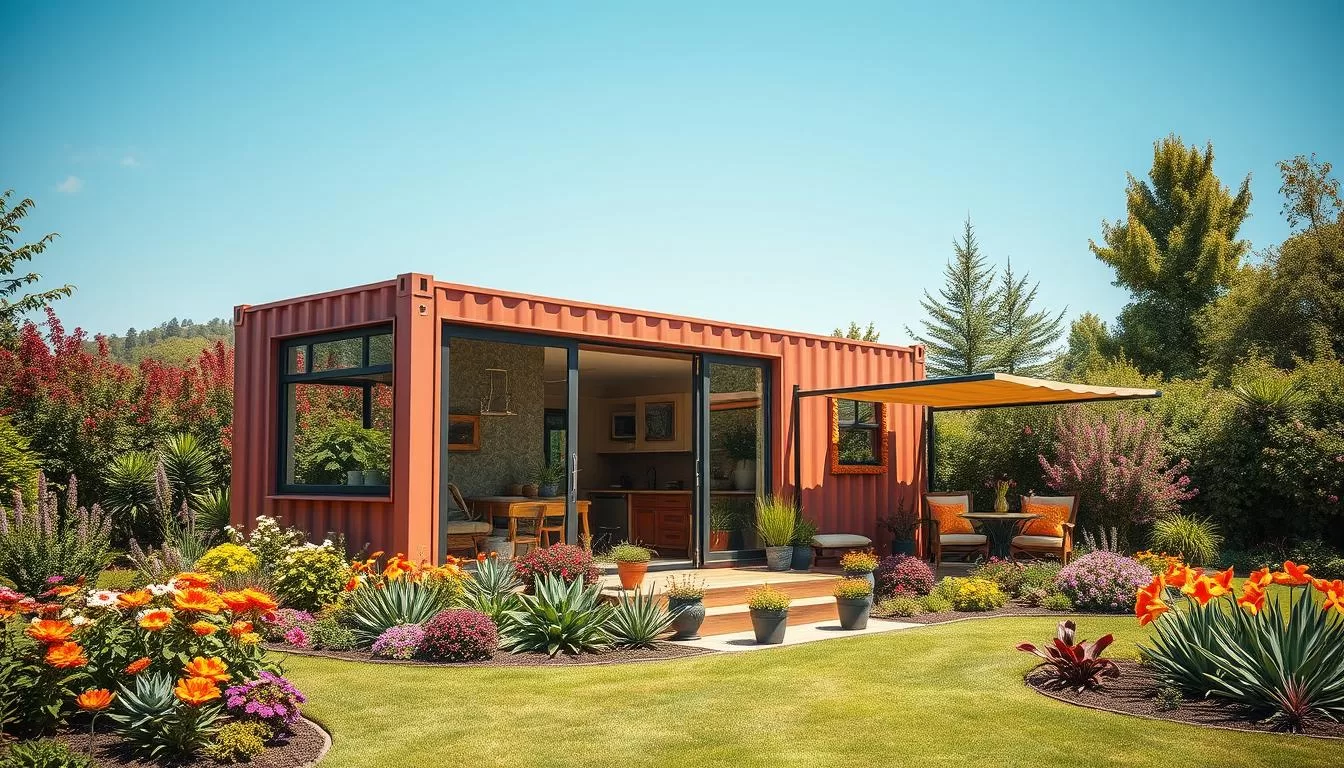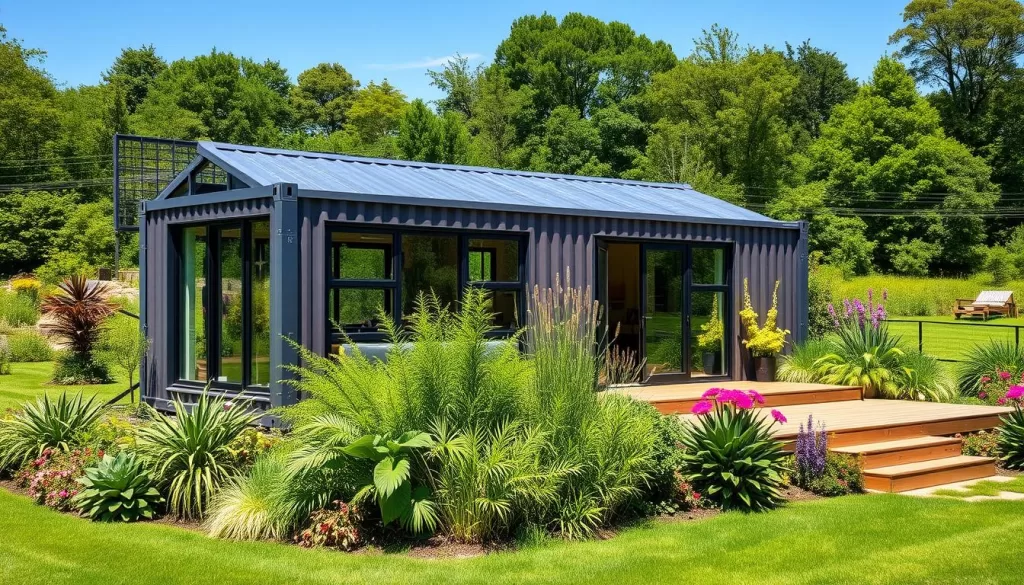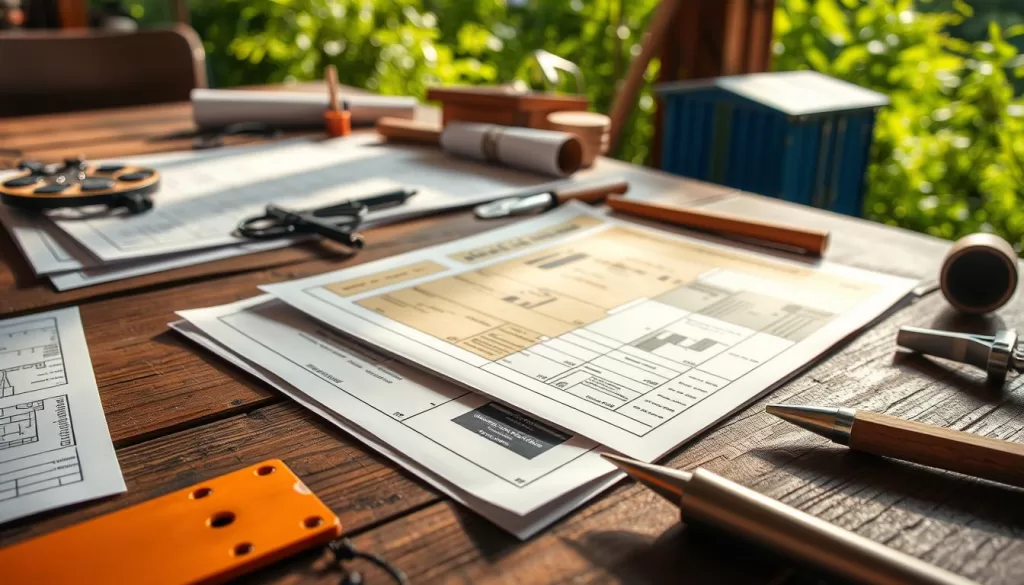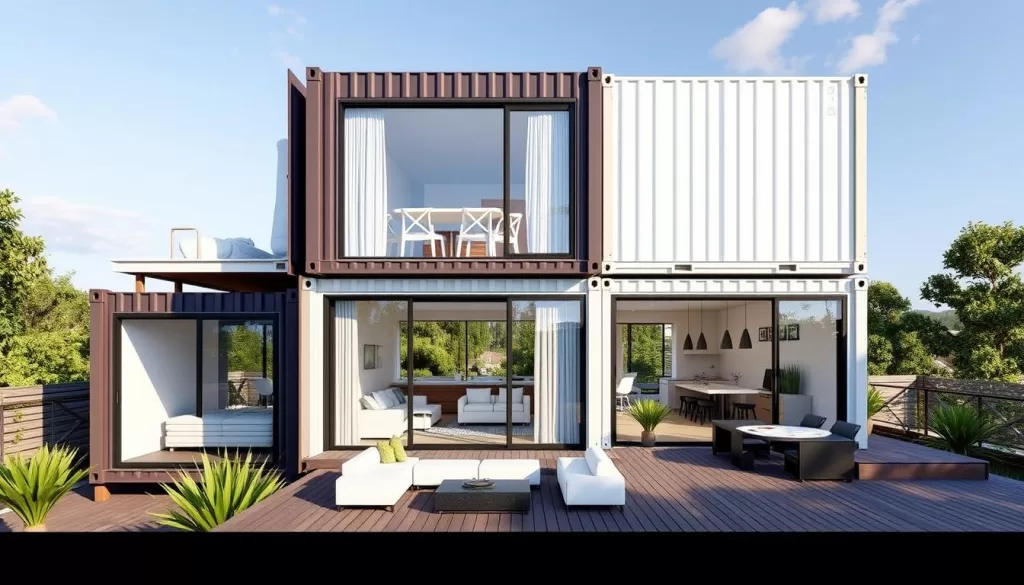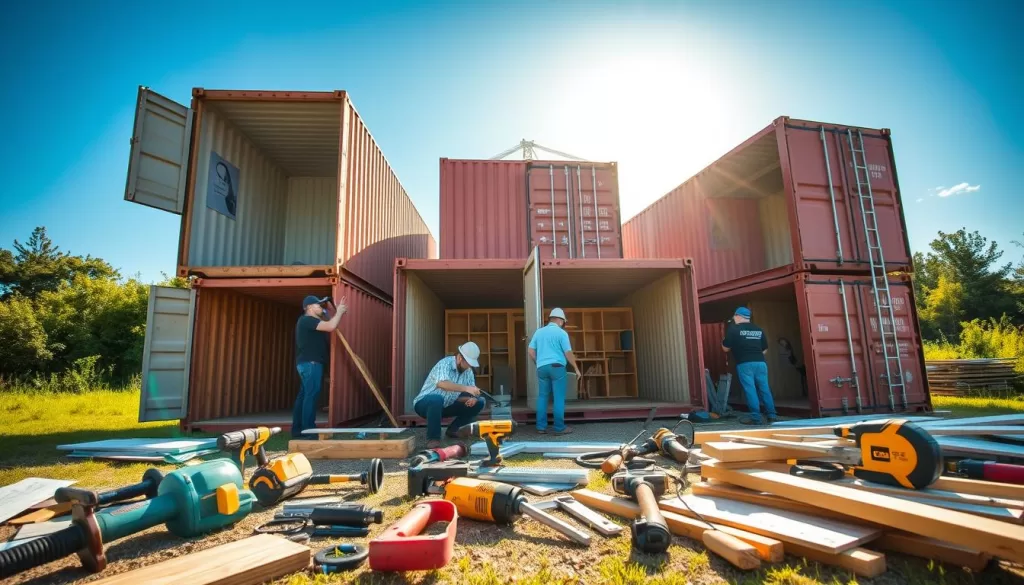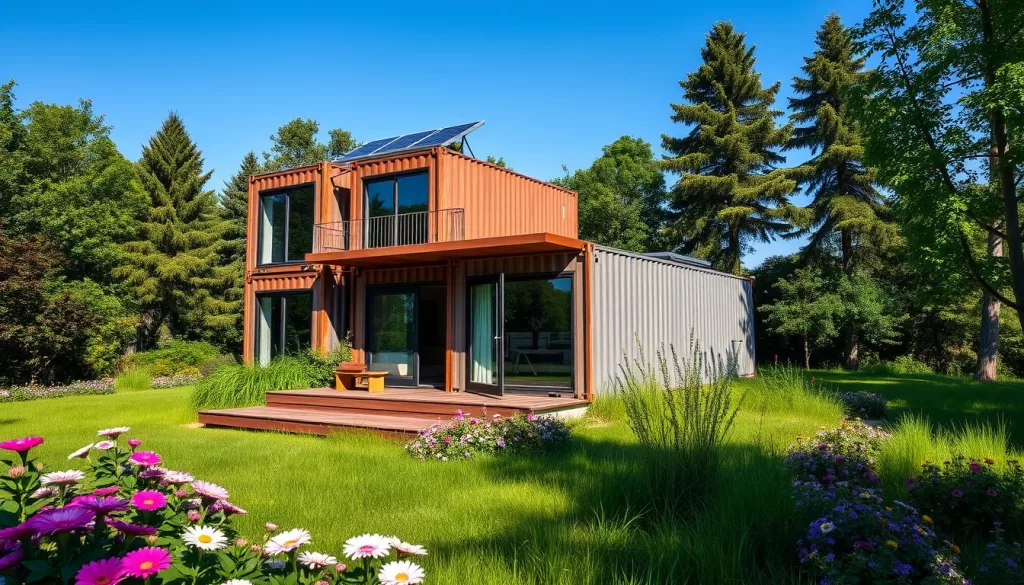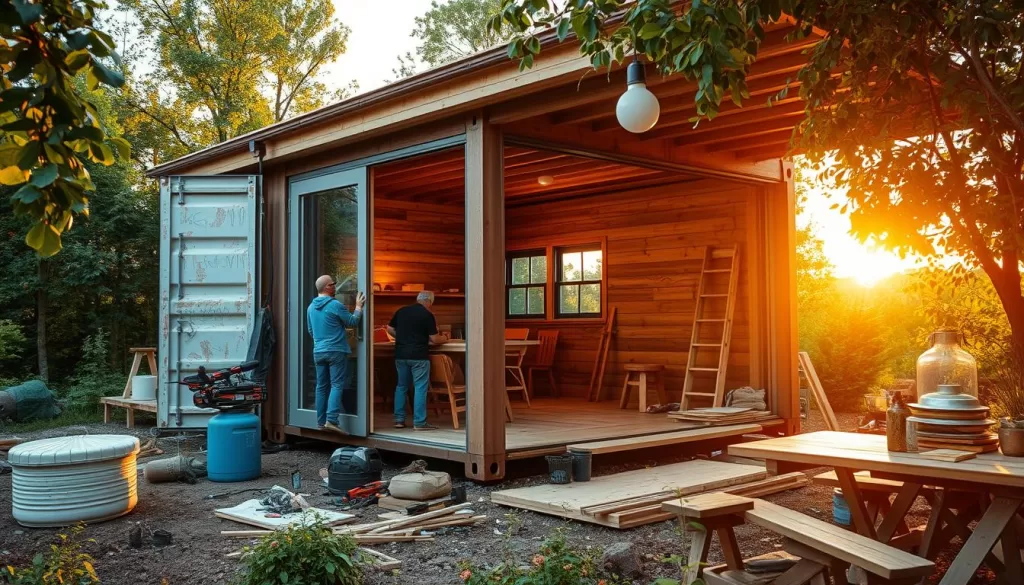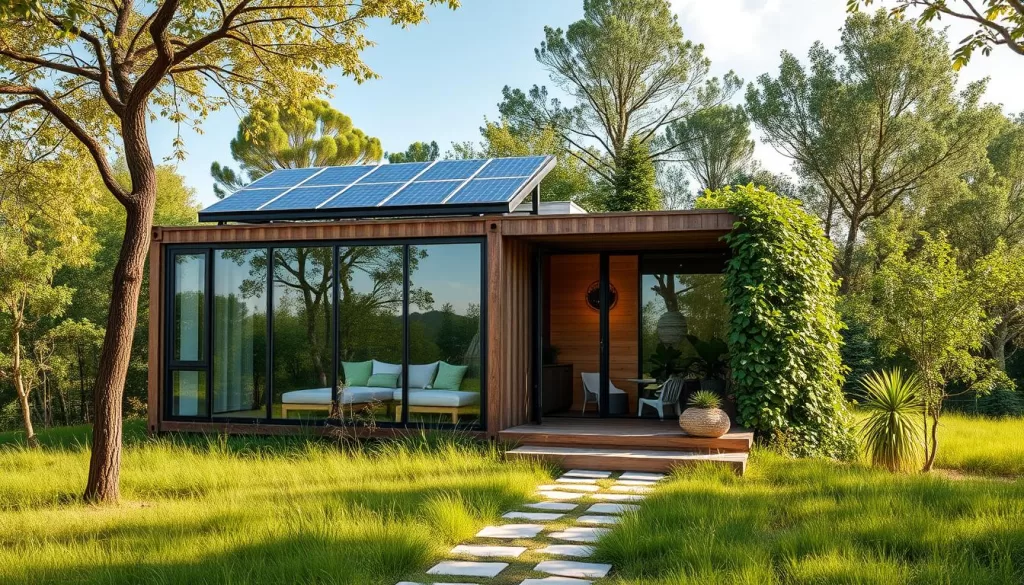Crafting Your Dream Home: DIY Container Homes
Shipping container homes are affordable, with prices from $150 to $350 per square foot1. This makes them a great choice for those looking for a sustainable and cost-effective home. You can find plans for any size and style, and even customize them to fit your taste. With the right planning, you can turn a shipping container into your dream home.
Building your own shipping container home is both exciting and challenging. The DIY container home movement is growing, with people choosing shipping containers for their homes. This is because used containers cost between $1,500 and $4,500 each1, making them a budget-friendly option.
Page Contents
- 1 Understanding DIY Container Homes: A Sustainable Housing Revolution
- 2 Essential Planning Steps Before You Begin
- 3 Selecting the Perfect Shipping Container for Your Home
- 4 Legal Requirements and Building Permits
- 5 Designing Your Container Home Layout
- 6 Essential Tools and Materials Needed
- 7 Step-by-Step Container Modification Guide
- 8 Interior Finishing and Systems Installation
- 9 Eco-Friendly Features and Sustainable Solutions
- 10 Conclusion: Making Your Container Home Dream a Reality
- 11 FAQ
- 11.1 What are the benefits of DIY container homes?
- 11.2 What are the essential planning steps before building a DIY container home?
- 11.3 How do I choose the perfect shipping container for my home?
- 11.4 What legal requirements and building permits do I need for a DIY container home?
- 11.5 How do I design the layout of my DIY container home?
- 11.6 What tools and materials are needed for a DIY container home?
- 11.7 How do I modify a shipping container for housing?
- 11.8 What considerations are involved in interior finishing and systems installation?
- 11.9 What eco-friendly features and sustainable solutions can I incorporate into my DIY container home?
Key Takeaways
- You can build a diy container home with a budget of $25,000 to $175,000, depending on size and customization2.
- Shipping container homes can be a sustainable option, with the ecological benefits of repurposing shipping containers contributing to waste reduction1.
- Container home prices can vary greatly, from $12,000 for prefabricated homes to $2 million or more for elaborate designs2.
- The average cost per square foot for shipping container homes ranges from $150 to $3501.
- You can find container home plans and shipping container homes that suit your needs and budget.
- Building a container home requires creative adaptations for plumbing, windows, and doors due to their original design for shipping purposes2.
Understanding DIY Container Homes: A Sustainable Housing Revolution
Thinking about eco-friendly home construction? Container homes are a big part of the sustainable housing solutions movement. They help reduce waste and cut down on carbon emissions. This makes them popular, especially for those into tiny house living3.
About 60% of travelers like staying in unique places like container homes more than hotels3.
Container homes offer many benefits. They can cut building costs by up to 50% compared to traditional houses4. You can also customize them to fit your style, making sustainable living personal5.
The global market for container homes is growing fast, with a 7.5% CAGR from 2023 to 20304. This shows container homes are a good choice for affordable, sustainable housing.
Container homes have several advantages:
- Affordability: They cost around $40,000 to $46,000, which is cheaper than regular houses5.
- Space efficiency: They can be very efficient, with some designs covering 2,000 square feet5.
- Sustainability: Made from reused shipping containers, they help reduce waste and support green building5.
As more people look for sustainable homes, container homes are becoming more important. They offer a mix of affordability, green living, and customization. This makes them a great choice for those wanting a tiny house living experience3.
Essential Planning Steps Before You Begin
Building off-grid container homes requires careful planning. You need to check local zoning laws, get the right permits, and design your layout. The global shipping container homes market is expected to grow a lot, showing how popular affordable diy home projects like container home construction are becoming.
To start, consider these steps:
- Research local building regulations and obtain necessary permits6
- Design your layout and choose the right container size7
- Plan for insulation, electrical, and plumbing installations
A well-planned container home construction project can lead to a beautiful and functional home. With the right materials and design, you can make an off-grid container home that’s both sustainable and affordable. Used shipping containers can be bought for about $2,500, and new ones for around $5,000, making affordable diy home projects possible.
By following these essential planning steps, you can have a successful container home construction project. And enjoy your new off-grid container home.
| Container Size | Living Space | Cost |
|---|---|---|
| 20-foot | 160 square feet | $2,000 – $3,000 |
| 40-foot | 320 square feet | $3,000 – $5,000 |
Selecting the Perfect Shipping Container for Your Home
Choosing the right container is key when building a shipping container house. You can pick between new and used containers, each with its own benefits and drawbacks. Prices vary, with new containers costing more but lasting longer and looking better8.
Used 20 ft containers start at $2,5009. New ones might be pricier but are more durable and stylish10.
Think about the size and layout you need. A 20 ft container gives about 160 square feet of space9. A 40 ft one offers around 320 square feet9. Do it yourself tiny homes are perfect for those wanting a small, green living space.
Always check the container before buying. Look for damage, rust, or wear. A good container is the base for your diy sustainable housing project. With the right container and creativity, you can build an eco-friendly home that fits your budget and needs.
Legal Requirements and Building Permits
Building self-built container dwellings requires knowing the legal rules and getting the right permits. About 70% of American cities have laws about how land can be used, with places like Houston, Texas11 being exceptions. So, you must check and follow local rules before starting your affordable container home project.
Prefabricated container home kits make building easier, but you must still follow local building codes. In the U.S., these codes are based on the International Code Council’s International Residential Code (IRC) and International Building Code (IBC), updated every 1-2 years11. Not following these codes can lead to fines or even having your structure torn down12.
To get through the permitting process, knowing your area’s specific rules is key. Some states, like Massachusetts, have their own building codes that might not match national ones11. Doing your homework on local rules before starting can save you money and avoid legal trouble11.
Here are some important things to think about when getting building permits for your container home:
- Research local zoning laws and building codes
- Ensure compliance with safety standards for electrical, plumbing, and structural elements
- Submit detailed plans and schedules to local authorities
By knowing the legal needs and permits for container home building, you can make sure your project goes smoothly. This is true for both self-built container dwellings and prefabricated container home kits.
Designing Your Container Home Layout
Designing your container home layout lets you be creative and build a space that’s all your own. With diy eco-friendly housing, you can pick from many container home design ideas. A 20-foot container gives about 320 square feet of space13. A 40-foot one offers around 640 square feet13.
You can also use multiple containers to arrange your space in different ways. This helps make the most of your space and lets in more sunlight14.
Using 3D design software can really help with planning your layout15. It lets you see both 2D floor plans and 3D models. This makes it easier to see how your design will look. Adding wall-to-wall glass doors can also make your space feel more open, especially to outdoor areas like patios15.
There are many design layouts to choose from, like single-container homes or designs with two containers15. Even small changes, like adding an extension, can make a big difference in how your home feels15. With a little creativity, you can create a unique and cozy container home that’s all your own.
Essential Tools and Materials Needed
Building a shipping container home requires the right tools and materials. You’ll need a reliable welder, like the Hobart 500559 Handler 140 MIG Welder, which costs $624.9916. Also, a DEWALT Angle Grinder is essential, priced at $85.9516. Using eco-friendly materials can also help reduce your project’s carbon footprint.
A well-planned shipping container home can be an eco-friendly home. Its durable corten steel exterior makes it strong, designed to withstand extreme weather17. You’ll need corrugated steel, tube steel, wood, drywall, insulation, electrical wiring, and plumbing fixtures for construction17.
When choosing materials, consider their cost, durability, and sustainability. Upcycling materials and appliances can also save money17. With the right tools and materials, you can create a unique and eco-friendly home that fits your needs and budget.
- Welder: for connecting containers and structural integrity
- Angle grinder: for cutting and smoothing metal edges
- Insulation: for reducing heat loss and energy consumption
- Sustainable materials: for reducing the carbon footprint of your project
Choosing the right tools and materials lets you build a shipping container home that’s functional and eco-friendly. It’s a great choice for those wanting to build your own shipping container home18.
Step-by-Step Container Modification Guide
Modifying a shipping container for housing needs a solid plan. You must think about sustainable housing, affordable housing, and container house design. The cost of shipping containers varies from $1,400 to $4,500, making them a good choice for affordable housing.
Insulation is a key part of the modification. It can cut energy costs by about 30%, helping manage heating and cooling. For sustainable housing, insulation is crucial. You can use spray foam, rigid foam, or blanket batts, each with its own benefits and drawbacks.
Installing windows and doors is also vital. They let in natural light and air, improving the container house design. When picking windows and doors, look at durability, energy efficiency, and security. Regular checks for rust or corrosion are important for the container’s life, as19 advises.
Here are some key considerations for container modification:
- Cutting and reinforcement techniques to ensure structural integrity
- Insulation installation methods to minimize energy costs
- Window and door installation to enhance natural light and ventilation
By following these steps and thinking about sustainable housing and affordable housing solutions, you can make a unique and useful container house design. It will meet your needs and budget.
Always follow local building codes and regulations. If needed, get advice from experts for a successful container modification project20.
Interior Finishing and Systems Installation
When building a home from a container, finishing the inside is key. You’ll need to think about electrical wiring, plumbing, and wall finishes. For example, the distance to the nearest utility pole is about 70 feet21. This affects how deep the electrical trench should be, around 4 feet21.
Plumbing costs can be between $1,500 and $5,00022, depending on the system’s complexity. Electrical setup might cost between $1,200 and $3,50022, based on the features you want. It’s important to find a balance between cost and the look and feel of your home.
Some important things to think about for the inside include:
- Electrical wiring and panel installation
- Plumbing setup and fixture selection
- Wall finishing options, such as paint, trim, and molding
By planning well and doing these steps right, you can make a warm and welcoming space. It will show off the beauty of minimalist living, all thanks to your diy home project.
Remember to check local rules and permits needed for your project. These can change by state but usually include at least three permits22. With good planning and focus, you can make your dream home a reality. Enjoy the simple life in your repurposed container home.
Eco-Friendly Features and Sustainable Solutions
Starting your journey with a container home means focusing on eco-friendly features. You can add solar panels, rainwater systems, and recycled materials23. These elements help you live sustainably and save money on housing.
Container homes are great for the planet. They use less resources, make less waste, and cut down on emissions23. You can also use spray foam for insulation to save on energy costs23. Choosing sustainable materials and designs makes your home both green and budget-friendly.
Container homes are a smart choice for living sustainably. They can be built locally, saving on transport costs and emissions23. Adding solar panels or wind turbines provides clean energy24. This way, you get a home that’s good for the planet and your wallet.
- Use recycled materials for construction and decoration
- Install energy-efficient appliances and lighting
- Implement a rainwater harvesting system
- Incorporate solar panels or other renewable energy sources
By using these tips and adding eco-friendly features, you can build a home that’s both sustainable and affordable24.
Conclusion: Making Your Container Home Dream a Reality
Building your own25 container home is rewarding and good for the planet. It lets you create a unique space and help the environment26. Plus, container homes are easy to grow and change as you need26.
For a successful project, plan well and do your homework27. Know the local rules27 and get the right permits first. This way, you can turn a simple container into a stunning, green home that shows off your style.
Starting your container home project means you’re helping the planet26 and saving money27. Stay patient, keep going, and focus on living green. Your dream of a container home can come true26.

